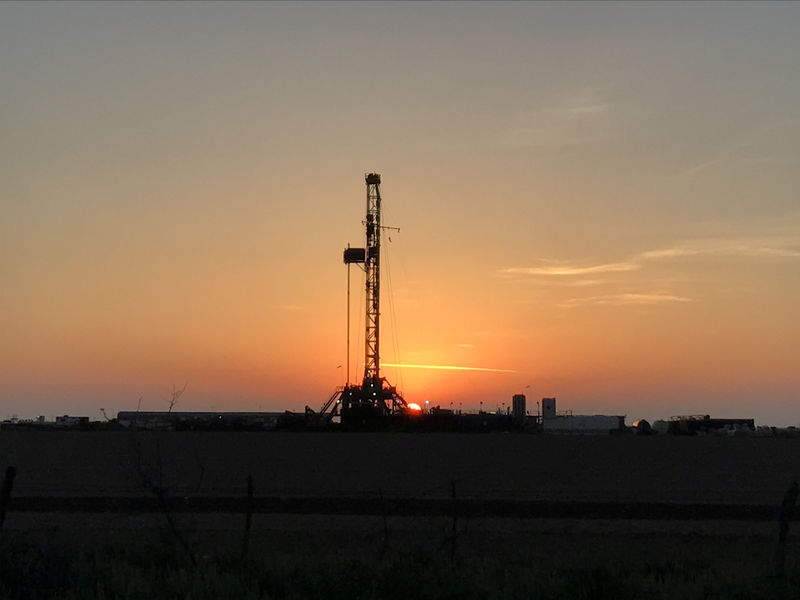By Ayenat Mersie and David Gaffen
NEW YORK (Reuters) - Many top U.S. shale oil producers are missing out on the rally in oil prices to more than $70 a barrel - because they sold their oil through futures contracts at about $55 last year when that looked like a good deal. Now, it looks cheap.
Those hedged bets will hold down revenues and further frustrate Wall Street investors, who have been disappointed by slow returns from the booming Permian Basin in west Texas.
The top 25 shale producers will forego about $1.7 billion in combined revenues in the second quarter with oil prices at about $70, according to Denver-based consultancy PetroNerds. Many of those producers used hedges that guaranteed them between $55 and $58 a barrel.
Some west Texas producers face a second profit-limiting dynamic: They are forced to cut prices because the region's production is overwhelming its pipeline network, raising transportation costs.
West Texas oil currently trades at a discount of $9 to U.S. benchmark futures, a spread that hit $12 earlier in the month.
Some firms earlier protected themselves from the widening gap with hedges against the discount.
But those that didn't - and also hedged against future prices at, for instance, at $55 - have been forced to sell barrels at prices in the low-to-mid $40s.
Occidental Petroleum Corp (NYSE:OXY), the biggest oil producer in the Permian, hedged using west Texas crude futures priced at about $59 a barrel, according to first-quarter regulatory filings. The company did not hedge against the Midland differential.
Occidential, which produces about 226,000 barrels per day (bpd) from the Permian, declined to comment on its hedging strategy. It could offset softer drilling revenues with better results from its pipeline unit, which benefits from the rising transportation costs.
LOST UPSIDE
Many firms sold their future output at prices in the $50s last year, hoping to take advantage of short-term rallies to lock in guaranteed income to cover drilling and production costs. Those costs can be $30 a barrel or less in west Texas, allowing the firms a healthy profit even as they protected themselves against future price slumps.
But the cost of that protection is to forego the potential upside of higher prices.
The second problem, with pipeline capacity, stems from surprisingly quick production growth that has pushed pipeline capacity to the limit several months before producers expected, said Michael Tran, global energy strategist at RBC Capital Markets.
Producers in west Texas, the nation's largest oilfield, are now pumping more than 3.3 million bpd, compared with 2.4 million bpd a year ago. With storage brimming and pipelines full, producers have had to offer steep discounts to compensate for rising transport costs.
The large gap between the U.S. futures price and Permian Basin oil is called the Midland differential - named for the town at the center of the west Texas oilfield boom.
Until recently, firms had not hedged the discount because the price of Midland oil and U.S. futures have historically tracked closely together. The market for such hedging is also less active, compared with futures hedging.
But at the end of the first quarter, 14 shale companies had hedged against 100 million barrels of 2019's production in West Texas, compared with just 40 million barrels at the end of the fourth quarter, according to a Reuters analysis of U.S. regulatory filings.
"It's really becoming a more widely used phenomenon," said Ben Montalbano, PetroNerds co-founder, who said Midland hedging volume has increased tenfold in the last two years.
Coming into this year, Cimarex Energy Co (NYSE:XEC) had hedged about 905,000 barrels of 2019 west Texas production at a 47-cent discount to U.S. benchmark futures. That means if U.S. oil futures trade at $70 a barrel, Cimarex would sell oil at $69.53 - as opposed to companies that didn't hedge, and are exposed to the entire Midland discount, now at $9.
In the first quarter, Cimarex increased its hedge against the differential to 3.1 million barrels, according to the firm's filings. About half of that, however, was hedged at a less favorable discount of $4.83 per barrel - effectively selling oil at $65 if futures are at $70.
Cimarex produced about 50,000 bpd in the Permian in the first quarter. The company did respond to a request for comment.
PIPELINE PROBLEMS
With major pipelines not expected to come online until next year and production increasing, analysts expect the Midland differential to remain high. Occidental, in a recent presentation, said it expects this gap to hit $20 a barrel by the third quarter.
"For the first time in three years, we have not had a pipeline to come on to alleviate the bottleneck," said Tran.
Some firms, including Apache Corp (NYSE:APA) and Pioneer Natural Resources, said they don't have to worry about the differential because they have reserved enough space on pipelines to transport their oil.
Apache said it has started to hedge its Midland exposure for 2019. Pioneer does not have any such positions, said Rich Dealt, CFO.

"Pioneer has firm transportation in place over the next few years to move nearly all of its Permian Basin oil production to the Gulf Coast for export or sale to refineries," Dealt said.